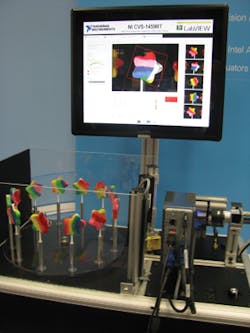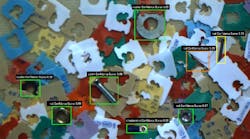FPGAs prove invaluable for developers wishing to speed point processing and neighborhood image processing operations. Incorporated into cameras, frame grabbers or vision-based computers, the pipelined logic and on-board memory of these devices provide the means to offload tasks such as Bayer interpolation, histogram equalization and flat-field correction from the host computer.
Programming such devices to perform these tasks does, however, require knowledge of hardware description language (HDLs) such as Verilog HDL or VHDL and the compilation, simulation, programming and verification tools used to complete an FPGA design.
To allow developers to program these devices more easily, Silicon Software (Mannheim, Germany; www.silicon-software.com) offers its VisualApplets hardware programing tool that uses graphical representations of standard image processing operators. When combined in a pipelined fashion, these can be used to combine standard image processing operators without any knowledge of FPGA programming or the circuitry, synchronization or timing of FPGA devices.
For data acquisition, instrument control, industrial automation, the LabVIEW graphical programming language and environment from National Instruments (NI; Austin, TX, USA; www.ni.com) can also be used to develop machine vision applications. At this year's NI Week, held in August, Dr. Dinesh Nair, Chief Architect and R&D Manager with the company's Vision Development Group showed how the company's latest Vision Development Module could be used to speed over fifty FPGA image processing functions running on numerous embedded modules, frame grabbers and Compact Vision Systems (CVSs).
To perform imaging processing tasks using these image filters, morphological operators and color manipulation algorithms, developers use NI's Vision Assistant configuration tool to wire the block functions into the required configuration. Once complete, Vision Assistant then automatically generates a complete NI LabVIEW project including the host processor virtual instrument (VI), FPGA VI and code to transfer images between the processor and FPGA.
Using the Vision Assistant, developers can also modify the image processing algorithms using LabVIEW FPGA IP Builder. As well as speeding the task of generating this code, the Vision Assistant estimates the percentage usage of slices, LUTs, DSPs, and Block RAM for the entire image processing code and each individual algorithm. In this way, designers can visualize which step requires the most resources for the FPGA in each specific embedded module, frame grabber or vision system that may be targeted. These include the company's latest Compact Vision System, the CVS-1459RT and sbRIO-9651 System on Module (SOM) both of which were announced at the show.
Like its predecessor, the CVS-1457RT CVS, the company's latest vision system, the CVS-1459RT is a fan-less system that combines image input, CPU, memory and VGA output into a single unit. Unlike the 1457RT CVS, however, the CVS-1459RT uses two USB3 vision ports, each with its own xHCI dedicated controller and a more powerful 1.91GHz quad-core Intel Atom processor. Capable of running 64-bit real time Linux, the system also features FPGA coupled I/O and numerous opto-isolated I/O lines.
At NI Week, the company demonstrated how image processing algorithms running on the Xilinx (San Jose, CA, USA; www.xilinx.com) Spartan-6 LX25 FPGA in the CVS could be used with an acA640-120uc USB3 camera from Basler (Ahrensburg, Germany; www.baslerweb.com) to analyze the color and shape of candy.
Although such systems may be useful in factory floor environments, developers of portable embedded systems are looking for similar capabilities in smaller form factors. For this reason, NI has introduced its sbRIO-9651 System on Module (SOM), a 2 x 3in board that combines a Xilinx Zynq-7020, 667 MHz Dual-Core ARM Cortex-A9 and an Artix-7 FPGA.
To develop products using this board, NI supplies a reference board that allows developers to access the board's Gigabit Ethernet, USB 2.0 and RS232 interfaces as well as add peripheral I/O using additional boards that conform to the Pmod interface developed by Digilent (Pullman, Washington, USA; www.diligentinc.com).
Although the sbRIO-9651 will not ship for another month, Sébastien Boria and his colleagues at Airbus (Toulouse, France www.airbus.com) have used the board in the development of a number of vision-based smart tightening tools that aid the operator when performing tasks such as drilling, measuring, and quality data logging and tightening the over 400,000 fixtures used in aircraft assembly.
In operation, vision-enabled glasses transfer images to the sbRIO-9651 that is embedded in the operator's suit. Captured images are then processed, analyzed and the correct torque set for the tool. Images of the fixture to be tightened are then displayed on the glasses, eliminating any human error.
Vision Systems Articles Archives






